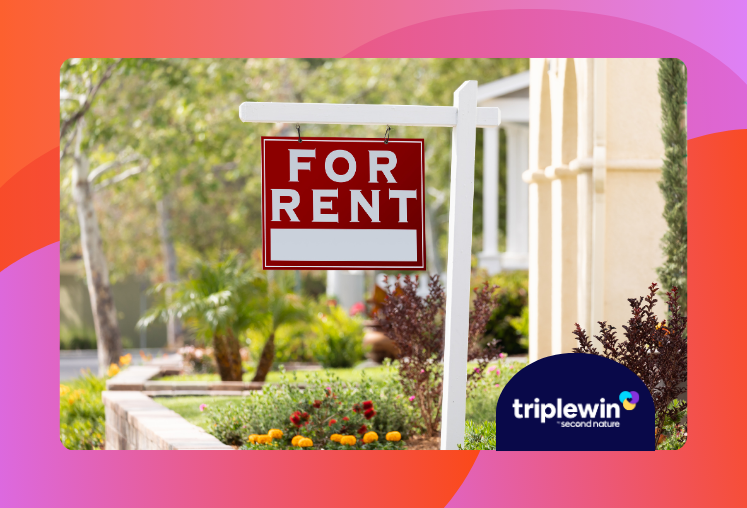When a new resident moves into your rental property, a positive first impression is the key to setting the tone for your future relationship with them. One straightforward way to do this is through a warm, well-written tenant welcome letter.
In today’s post, we’ll examine the importance of this welcome letter in detail and what you should include. We’ll also provide a free tenant welcome letter template to help you get started.
Note on language: At Second Nature, we prefer to say “resident” rather than “tenant,” but will use the terms interchangeably since many property managers are using long-standing document management conventions to leverage these checklists.
What Is a Tenant Welcome Letter?
A tenant welcome letter is a document sent by a real estate property manager to new residents prior to the move-in date.
Its purpose is to:
- Provide important information about the property
- Outline expectations related to resident responsibilities
- Make the new residents feel both welcomed and informed
- Create a positive relationship between the resident and property manager
The letter will typically include details about move-in procedures, contact information, property rules, and any neighborhood amenities. (Don’t worry–we’ll discuss this further in the blog.)
Why Should You Send a Tenant Welcome Letter?
Beyond just the all-important positive first impression, sending a tenant welcome letter has several other benefits:
- Highlights your brand: For property management companies, new tenants are an opportunity to showcase your brand. A well-crafted welcome letter demonstrates professionalism and shows you care about the comfort and satisfaction of their tenancy.
- Provides move-in instructions: Clear instructions about the move-in day (including any specific procedures or requirements) will help ease the often stressful and overwhelming process of moving into a new home.
- Eases the transition: By providing detailed information about utilities, local amenities, and property rules – as well as anticipating any questions your residents might have, you help them feel at home more quickly.
When to Send a Tenant Welcome Letter
The best time to send a new tenant their welcome letter is after both parties (the resident and property manager) have signed the lease agreement but before the resident’s move-in day.
Sending the letter in between this period gives the residents enough time to review the information in detail and ask any questions before they officially move in. This is also an ideal time to inspect the property and schedule any necessary repairs before move-in day.
Related: Property Management Rental Inspection Checklist
If you don’t have a tenant move-in checklist, we have you covered. Check out our Tenant Move-In Checklist for a free template you can customize.
What to Include in a Tenant Welcome Letter
Start the relationship on a positive note by focusing on the resident’s experience. A welcome letter to tenants from property managers is pivotal to their tenancy and should include helpful information that addresses common questions or issues that may come up during the move-in process, and acts as a good reference point, as well.
Property manager’s contact information
Provide your contact information, including your phone number and email address, so residents know how to reach out to you for any questions or issues. Be sure to mention what days of the week and hours you’re available, and additional contacts they can reach out to if you’re not free.
Details about move-in day
Include specific instructions for move-in day, such as any loading zone rules and areas, moving truck parking information, or designated move-in times to make their move-in experience more convenient.
Move-in checklist
Offer a list of tasks the resident needs to complete before and after moving in, such as setting up utilities and obtaining renters insurance. To make their lives easier, send them a list of providers and their contact information. We’ve got you covered with a tenant move-in checklist you can modify to fit your needs.
Local utilities
As mentioned, within the move-in checklist, you’ll want to provide information on how to set up local utilities such as electric, gas, cable or internet, water, and sewer services. Share details about how to pay for them, as well. This should include information about local utility companies and providers to save them time. If any cost is covered by the property management company, be sure to mention it.
Lucky for property managers, Second Nature offers move-in concierge services as part of their Resident Benefits Package to provide ease and convenience to residents. Learn more about our move-in concierge services.
Property walkthrough
Schedule a time and date for the property walkthrough, ensuring that all parties (residents and property manager) are aware of the current condition of the property before move-in day.
Related: Rental Inspection Checklist
Key collection details
Inform the resident where they can go to pick up the keys to their new home, as well as when–what days of the week and during your business hours. If they can’t pick up the keys during your preferred time, provide a contingency plan for key pickup.
Renters insurance
Remind residents to provide proof of renters insurance (if it’s required), and be sure to link to specific resources that explain the benefits of renters insurance. Second Nature offers renters insurance as part of our Resident Benefits Package.
Learn more about Second Nature’s renters insurance.
Rent payment
Explain when rent payments are due, as well the full rent amount is on a monthly basis and the payment methods available (such as an online portal). Share information about what late fees are if rent isn’t paid on time.
Maintenance issues
Outline the procedure for maintenance requests and provide emergency contact information for plumbing, HVAC, or electrical problems. See also: Preventive Maintenance Checklist for Property Management.
Trash collection and recycling
Provide information on where to dispose of trash and recycling, as well as collection days and any special disposal instructions, such as for bulk items.
Parking information
Explain parking arrangements for tenants, as well as any of their guests. This could include information about permits or designated spots.
Neighborhood information
Share information about local grocery stores, parks, gas stations, public transportation, and local attractions to help residents get familiar with their new neighborhood.
Overall tenant responsibilities
Reiterate key responsibilities, such as any necessary minor repairs and upkeep, to ensure residents are aware of their duties. (These will already have been outlined in the rental agreement, but it doesn’t hurt to reference them here.)
Property rules
Summarize the property rules and regulations, and be sure to refer to the lease agreement for detailed descriptions.
Tenant Welcome Letter Template
Below is a tenant welcome letter example you can use or customize to suit your unique needs:
[Property Manager's Name]
[Property Management Company]
[Address]
[City, State, ZIP Code]
[Phone Number]
[Email Address]
[Date]
Dear [Tenant's Name],
Welcome to [Property Name/Address]! We are excited to have you as a new resident. To help you settle in, we’ve put together this welcome letter with important information and resources.
Move-In Day Details:
- Move-in Date: [Date]
- Move-in Time: [Time]
- Loading Zone Rules: [Details]
Contact Information:
- Property Manager: [Name]
- Property Management Company: [Name]
- Phone: [Phone Number]
- Email: [Email Address]
Key Pick-Up:
- Date and Time: [Date and Time]
- Location: [Location]
Utility Set-Up:
- Electric: [Provider Contact Information]
- Gas: [Provider Contact Information]
- Cable/Internet: [Provider Contact Information]
- Water: [Provider Contact Information]
- Sewer: [Provider Contact Information]
Rent Payment:
- Monthly Rent: [Amount]
- Due Date: [Due Date]
- Payment Method: [Online Portal/Other]
Maintenance Issues:
- Report Issues: [How to Report]
- Emergency Contacts: [Contact Information]
Trash and Recycling:
- Location: [Details]
- Collection Days: [Days]
Parking Information:
- Tenant Parking: [Details]
- Guest Parking: [Details]
Neighborhood Information:
- Grocery Stores: [Details]
- Parks: [Details]
- Public Transportation: [Details]
- Local Attractions: [Details]
Tenant Responsibilities:
- [Responsibilities]
Property Rules:
- [Summary of Rules]
We hope this information helps you settle in comfortably. If you have any questions or need assistance, please don't hesitate to contact us.
Best regards,
[Property Manager's Name]
[Property Management Company]
How to Send a Tenant Welcome Letter
Email is the most efficient method of sharing the welcome letter since it ensures prompt delivery and allows residents to reference the information easily. It’s also good practice to provide a printed copy of the welcome letter upon move-in. You can simply leave it on the kitchen counter or another visible spot in their new home.
Final Thoughts
A tenant welcome letter is a simple yet powerful mechanism for enhancing the resident experience, fostering a positive relationship, and showcasing your brand. Ultimately, by providing essential information and a warm welcome, you are setting the stage for a smooth move-in process and a happy residency.
For more ways to improve the resident experience, check out our Resident Benefits Package.



